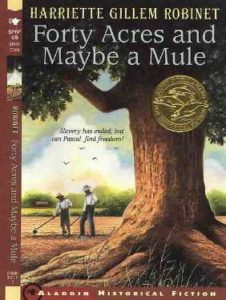 This chapter book of historical fiction by Harriette Gillem Robinet is one of the best resources available for elementary school classrooms on the Reconstruction era.
This chapter book of historical fiction by Harriette Gillem Robinet is one of the best resources available for elementary school classrooms on the Reconstruction era.
40 Acres and Maybe a Mule tells the story of Pascal, who is still enslaved at the end of the Civil War. When his older brother Gideon, who had run away to join the Union Army earlier in the war, returns with news of the government distributing “40 acres and a mule” to freed families, Pascal decides to follow his brother off the plantation. After gathering Pascal’s friend Nelly, an eight-year old girl who had been sold away from her family, the three begin a journey across South Carolina and eventually into Georgia to begin a new life in freedom. Along the way they meet other freed people they incorporate into their new family.
In Georgia, they are given forty acres near a poor white family that they befriend. They help the poor white family and hire other Black people to work the land. They go to an integrated school and Union League meetings in town. The reader becomes invested in the success of their farm and the happiness of the characters. Tragically, the book ends with them losing their farm to someone who is a “nightrider” and a former slave owner. The family breaks apart, but the three original characters journey to the Georgia Sea Islands in the hope of acquiring a new farm.
In summary, the book covers some of the most important themes of the Reconstruction era: the kinship networks that formerly enslaved people formed after the war in response to how slavery decimated family ties, the alliances Black freed people made with sympathetic poor whites in the South and how these groups were organized into Union Leagues, the intense desire for schooling after the war, the white backlash organized to re-implement slavery by another name. While the book doesn’t give a strong sense of the resistance Black and white Republicans organized in response to the backlash, it does show the resiliency and growing expectations of formerly enslaved people at the end of the war.
Throughout the book the characters discuss the key question of the Reconstruction era: what does it mean to be free? By focusing on the brief moment when freedom could mean economic independence and Black landownership, the book shows the promise of Reconstruction and gives the reader a strong emotional connection to the profound loss of this possibility.
Winner of the 1999 Scott O’Dell Award for historical fiction for children.
ISBN: 9780689833175 | Alladin
Learn more in the Zinn Education Project national report, “Erasing the Black Freedom Struggle: How State Standards Fail to Teach the Truth About Reconstruction,” and find teaching resources on Reconstruction below.












Harriette Gillem Robinet this is an very astonishing, flamboyant, and interesting book. I would love to congratulate you on your amazing story. (I am an 11 year old girl in 5th grade.)